Beauty and decay: inside America’s derelict movie theatres
In a new photobook, photographers Yves Marchand and Romain Meffre capture a bygone era of entertainment through decaying American movie theatres
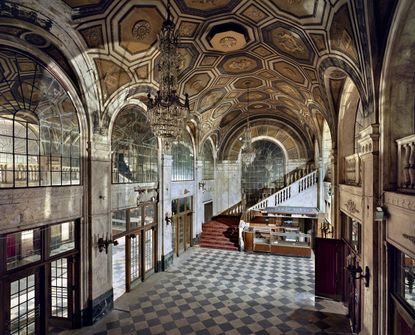
There’s something divine about decay. Traces of what once was; eras of very different social concerns, tastes and aspirations.
Movies can give us a window into the past, and as French photography duo Yves Marchand and Romain Meffre are proving, so too can movie theatres, particularly those partially chewed up by time.

Fox Theater, Inglewood, CA.
They can still be found in many American towns; majestic shrines to film, constructed during the golden age of the entertainment. But these cinemas now stand in various states of decades-long abandonment, empty, derelict, or reborn as something else entirely. Movie Theaters, published by Prestel, is an ode to these iconic American structures, or what remains of them.
This book isn’t the duo’s first taste of tatters. They began their collaboration in 2002 by exploring Parisian remains and have published books including The Ruins of Detroit and Gunkanjima.
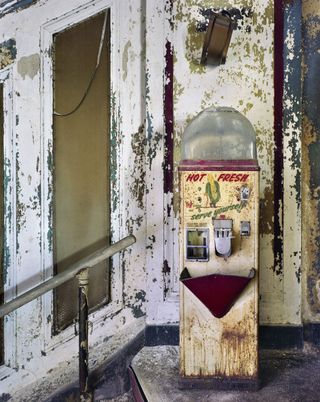

Top: Proctor’s Theater, Newark, NJ. Above: Paramount Theater, Newark, NJ.
The early 20th-century brought with it an entertainment boom. Hundreds of theatres popped up across the US, with many major movie studios commissioning architects to build extravagant, palatial auditoriums to satisfy the swelling appetites of spectators.
Since 2005, photographic duo Marchand and Meffre have travelled across America to visit these theatrical relics. In hundreds of lushly coloured images, they have captured the rich architectural diversity of the theatres’ exteriors and interiors, from neo-Renaissance to neo-Gothic, Art Nouveau to Bauhaus, neo-Byzantine to Jugendstil.
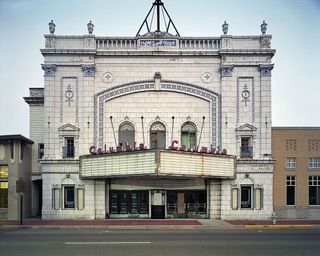
Columbia Theatre, Paducac, KY, 2011. Opened in 1927 and designed (1,200 seats) by Louisville-based architect W Earl Gore for Kentucky theatre operators Leo F Keiler and Rodney C Davis of Columbia Amusement and Realty Company. In the 1950s, it was modernised and partially remodelled in the Skouras style. In 1967, it was divided and a second screen was added on the balcony. It closed in 1987 and the asbestos fire curtain was renovated in 2013. It is currently awaiting renovation.
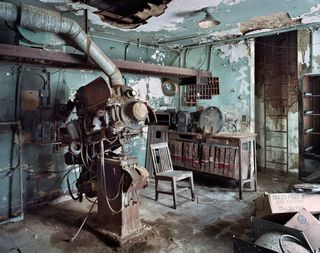
Robins Theaters, Warren, OH.
Armed with a large-format camera, they composed images spanning landscape exteriors to intimate close-ups. There’s beauty in the flaking paint, opulence in the rows of tattered crushed-velvet seats, stories retained in the defunct equipment and abandoned concession stands. Laughs, tears, screams and gasps live on in the crumbling cornices.
Wallpaper* Newsletter
Receive our daily digest of inspiration, escapism and design stories from around the world direct to your inbox
Some sites have not been left entirely for dead. But as the 1960s matured, so too did domestic TV sets and multiplexes. During the following decades, the heyday of the movie theatre was tarnished by modernisation. These majestic buildings, in turn, began taking on less majestic roles: bingo halls, basketball courts, bus depots, warehouses, fitness centres, flea markets, car parks and retail stores.
In contemporary times, where streaming services reign and convenience outshines occasion, Marchand and Meffre’s book is not just an appetising visual record of the majestic movie palace, it’s a timely eulogy for a entertainment’s golden years. Decay, in its divinity, is evidence that things have moved on, for better or worse.
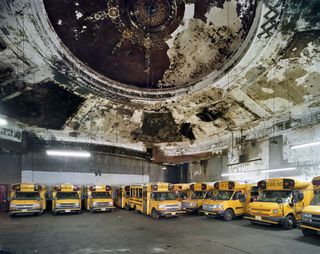
State Theater, West Orange, NJ.

Meserole Theater, Brooklyn, NY.

Loew’s Kings Theatre, Brooklyn, NY, 2007. Opened in 1929, designed (3,676 seats) by architects Rapp and Rapp and Edwin C A Bullock for the Loew’s Theatres chain. It was forced to close due to poor attendances in the mid-1970s and was then independently operated from 1977 as the Kings Theatre but closed just six weeks later with Bruce Lee: The Man, The Myth. It sat vacant for more than three decades until a $93m restoration started in 2010. The Kings Theatre reopened in 2015 as a performing arts venue.
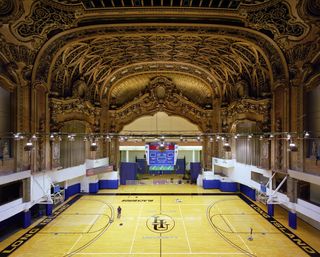
Paramount Theater, Brooklyn, NY.

Spooner Theater, Bronx, NY.
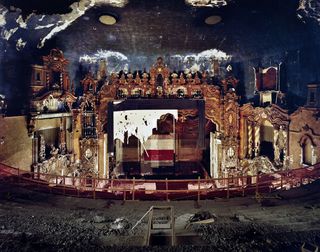
RKO Keith’s Flushing Theater, Queens, NY.

Midway Theatre, Rockford, IL, 2014. Opened in 1918, designed (1,500 seats) by architect John E O Pridmore. It was successively operated by the Ascher Brothers circuit and Balaban & Katz Corp. In 1980 a fire damaged the building, and after restoration it hosted the Rockford Symphony Orchestra, finally closing in 2006. In 2012, the roof partially collapsed. The building has since been stabilised and is awaiting renovation.

Proctor’s Theater, Troy, NY.
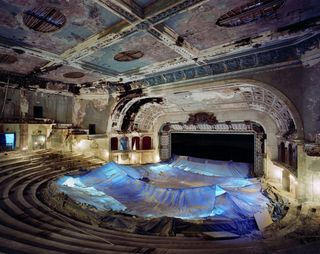
Meserole Theater, Brooklyn, NY.
INFORMATION
Movie Theaters, by Yves Marchand and Romain Meffre, £60, published by Prestel on 4 November 2021., prestelpublishing.penguinrandomhouse.de
Harriet Lloyd-Smith was the Arts Editor of Wallpaper*, responsible for the art pages across digital and print, including profiles, exhibition reviews, and contemporary art collaborations. She started at Wallpaper* in 2017 and has written for leading contemporary art publications, auction houses and arts charities, and lectured on review writing and art journalism. When she’s not writing about art, she’s making her own.
-
 The 2024 Ivor Novello nominations for songwriting have been revealed
The 2024 Ivor Novello nominations for songwriting have been revealed77 British and Irish songwriters and composers make up this year's nominees, announced tonight at London's Groucho Club
By Charlotte Gunn Published
-
 Why Bollinger’s La Grande Année 2015 champagne is worth celebrating
Why Bollinger’s La Grande Année 2015 champagne is worth celebratingChampagne Bollinger unveils La Grande Année 2015 and La Grande Année Rosé 2015, two outstanding cuvées from an exceptional year in wine-making
By Melina Keays Published
-
 Lexus installation explores time at Milan Design Week 2024
Lexus installation explores time at Milan Design Week 2024Lexus brought designer Hideki Yoshimoto’s ‘Beyond the Horizon’ to Milan’s Art Point, part of its ongoing series of collaborations with Fuorisalone
By Nargess Shahmanesh Banks Published
-
 The cosmos meets art history in Vivian Greven’s New York exhibition
The cosmos meets art history in Vivian Greven’s New York exhibitionVivian Greven’s ‘When the Sun Hits the Moon’, at Perrotin in New York City, is the artist’s first solo exhibition in the USA
By Emily McDermott Published
-
 Back to Black: all eyes on film-maker Sam Taylor-Johnson
Back to Black: all eyes on film-maker Sam Taylor-JohnsonBack to Black cinematographer Polly Morgan tells Wallpaper* how a shared love of French New Wave close-ups brought Sam Taylor-Johnson’s Amy Winehouse biopic to life
By Craig McLean Published
-
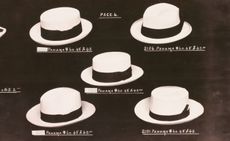 The Met’s ‘The Real Thing: Unpacking Product Photography’ dissects the avant-garde in early advertising
The Met’s ‘The Real Thing: Unpacking Product Photography’ dissects the avant-garde in early advertisingA new exhibition at The Metropolitan Museum of Art in New York explores the role of product photography and advertising in shaping the visual language of modernism
By Zoe Whitfield Published
-
 Detroit Institute of Arts celebrates Black cinema
Detroit Institute of Arts celebrates Black cinema‘Regeneration: Black Cinema 1898-1971’ at the Detroit Institute of Arts (DIA) brings lost or forgotten films, filmmakers and performers to a contemporary audience
By Anne Soward Published
-
 From Wall Street to Studio 54: a short film celebrates Larry Fink
From Wall Street to Studio 54: a short film celebrates Larry FinkCelebrating Larry Fink, Fellowship presents ‘Fink’, a short film diving into the pioneering photographer’s creative mind
By Tianna Williams Published
-
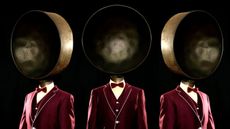 How Oscar-nominated ‘Anatomy of a Fall’ made a star of the most ear-popping song of the year
How Oscar-nominated ‘Anatomy of a Fall’ made a star of the most ear-popping song of the yearWallpaper* meets ‘Anatomy of a Fall’ favourites Bacao Rhythm & Steel Band, whose cover of 50 Cent's ‘P.I.M.P’ muscles its way into the Oscar-nominated courtroom drama
By Craig McLean Published
-
 BLUM marks 30 years of Japanese contemporary art in America
BLUM marks 30 years of Japanese contemporary art in AmericaBLUM will take ‘Thirty Years: Written with a Splash of Blood’ to its New York space in September 2024, continuing its celebration of Japanese contemporary art in America
By Timothy Anscombe-Bell Published
-
 Todd Gray’s sculptural photography collages defy dimension, linearity and narrative
Todd Gray’s sculptural photography collages defy dimension, linearity and narrativeIn Todd Gray’s New York exhibition, he revisits his 40-year archive, fragmented into elaborated frames that open doors for new readings
By Osman Can Yerebakan Published